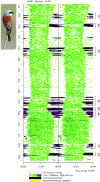Actogram analysis of free-flying migratory birds: new perspectives based on acceleration logging
- PMID: 28343237
- PMCID: PMC5522517
- DOI: 10.1007/s00359-017-1165-9
Actogram analysis of free-flying migratory birds: new perspectives based on acceleration logging
Abstract
The use of accelerometers has become an important part of biologging techniques for large-sized birds with accelerometer data providing information about flight mode, wing-beat pattern, behaviour and energy expenditure. Such data show that birds using much energy-saving soaring/gliding flight like frigatebirds and swifts can stay airborne without landing for several months. Successful accelerometer studies have recently been conducted also for free-flying small songbirds during their entire annual cycle. Here we review the principles and possibilities for accelerometer studies in bird migration. We use the first annual actograms (for red-backed shrike Lanius collurio) to explore new analyses and insights that become possible with accelerometer data. Actogram data allow precise estimates of numbers of flights, flight durations as well as departure/landing times during the annual cycle. Annual and diurnal rhythms of migratory flights, as well as prolonged nocturnal flights across desert barriers are illustrated. The shifting balance between flight, rest and different intensities of activity throughout the year as revealed by actogram data can be used to analyse exertion levels during different phases of the life cycle. Accelerometer recording of the annual activity patterns of individual birds will open up a new dimension in bird migration research.
Keywords: Accelerometer; Activity; Annual cycle; Bird migration; Flight pattern.
Figures







Similar articles
-
Activity patterns throughout the annual cycle in a long-distance migratory songbird, the red-backed shrike Lanius collurio.Mov Ecol. 2022 Dec 1;10(1):55. doi: 10.1186/s40462-022-00355-0. Mov Ecol. 2022. PMID: 36457000 Free PMC article.
-
Barrier crossing in small avian migrants: individual tracking reveals prolonged nocturnal flights into the day as a common migratory strategy.Sci Rep. 2016 Feb 15;6:21560. doi: 10.1038/srep21560. Sci Rep. 2016. PMID: 26876925 Free PMC article.
-
Flight by night or day? Optimal daily timing of bird migration.J Theor Biol. 2009 Jun 21;258(4):530-6. doi: 10.1016/j.jtbi.2009.01.020. J Theor Biol. 2009. PMID: 19459237
-
Hovering and intermittent flight in birds.Bioinspir Biomim. 2010 Dec;5(4):045004. doi: 10.1088/1748-3182/5/4/045004. Epub 2010 Nov 24. Bioinspir Biomim. 2010. PMID: 21098953 Review.
-
How do energy stores and changes in these affect departure decisions by migratory birds? A critical view on stopover ecology studies and some future perspectives.J Comp Physiol A Neuroethol Sens Neural Behav Physiol. 2017 Jul;203(6-7):411-429. doi: 10.1007/s00359-017-1166-8. Epub 2017 Mar 22. J Comp Physiol A Neuroethol Sens Neural Behav Physiol. 2017. PMID: 28332031 Review.
Cited by
-
The Effects of Commercially-Relevant Disturbances on Sleep Behaviour in Laying Hens.Animals (Basel). 2023 Oct 5;13(19):3105. doi: 10.3390/ani13193105. Animals (Basel). 2023. PMID: 37835711 Free PMC article.
-
Avian migration clocks in a changing world.J Comp Physiol A Neuroethol Sens Neural Behav Physiol. 2024 Jul;210(4):691-716. doi: 10.1007/s00359-023-01688-w. Epub 2024 Feb 2. J Comp Physiol A Neuroethol Sens Neural Behav Physiol. 2024. PMID: 38305877 Free PMC article. Review.
-
Increasingly detailed insights in animal behaviours using continuous on-board processing of accelerometer data.Mov Ecol. 2022 Oct 24;10(1):42. doi: 10.1186/s40462-022-00341-6. Mov Ecol. 2022. PMID: 36280879 Free PMC article.
-
Proximate mechanisms affecting seasonal differences in migration speed of avian species.Sci Rep. 2018 Mar 7;8(1):4106. doi: 10.1038/s41598-018-22421-7. Sci Rep. 2018. PMID: 29515154 Free PMC article.
-
Sleep research goes wild: new methods and approaches to investigate the ecology, evolution and functions of sleep.Philos Trans R Soc Lond B Biol Sci. 2017 Nov 19;372(1734):20160251. doi: 10.1098/rstb.2016.0251. Philos Trans R Soc Lond B Biol Sci. 2017. PMID: 28993495 Free PMC article. Review.
References
-
- Adamik P, Emmenegger T, Briedis M, Gustafsson L, Henshaw I, Krist M, Laaksonen T, Procházka P, Salewski V, Hahn S. Barrier crossing in small avian migrants: individual tracking reveals prolonged nocturnal flights into the day as a common migratory strategy. Sci Rep. 2016;6:21560. doi: 10.1038/srep21560. - DOI - PMC - PubMed
-
- Alerstam T. Bird migration speed. In: Berthold P, Gwinner E, Sonnenschein E, editors. Avian migration. Berlin: Springer; 2003. pp. 253–267.
-
- Alerstam T. Strategies for the transition to breeding in time-selected bird migration. Ardea. 2006;94:347–357.
-
- Alerstam T. Optimal bird migration revisited. J Ornithol. 2011;152(Suppl 1):S5–S23. doi: 10.1007/s10336-011-0694-1. - DOI
Publication types
MeSH terms
LinkOut - more resources
Full Text Sources
Other Literature Sources

